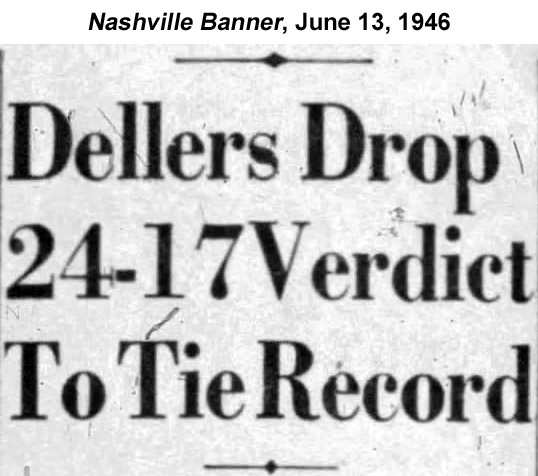
In what must be one of baseball’s most productive offensive games ever in Sulphur Dell, Chattanooga outlasted Nashville 24-17 in the second game of a doubleheader on Wednesday, June 12, 1946.
With the Shrine Circus scheduled for a five-day run at the historic ballpark the next week, sportswriter Raymond Johnson offered his view by comparing the wild game to circus shenanigans under the sub-heading “Vol-Lookout Gyrations Bring To Mind Shrine Circus”:
“…it is extremely doubtful if the circus will provide more amusing things than some of the comical and, at times, stupid play Those Vols, their rivals, and the umpires – let’s not forget them – have in the Dell this week.”[1]
Nashville won the first game that day by a score of 4-3, but the nightcap was one for the record books.
Nashville and Southern Association rival Chattanooga set a league record for most hits in one game for both teams with 51 and tied a league record for runs in a game with 41. There were 109 official times at-bat, 29 left on base, 15 doubles, three home runs, and 71 bases.[2]
What does not show up in the box score are other zany happenings.
Twenty-eight players, 12 Lookouts and 16 Vols, took part in the game. Nine pitchers, six Vols, and three Lookouts, took his turn on the mound. There were four hit batsmen and nine errors.
In the first inning, Nashville’s Joe Stringfellow golfed a long home run out of the ballpark. A few batters later second baseman Jim Shilling hit an infield popup which Lookouts third baseman Ray Goolsby, first baseman Jack Sanford, and pitcher Larry Brunke dropped between them. Shilling later pitched two innings for Nashville.
There was even a protest, although only rules interpretations can be protested, not judgment calls. In the fourth inning, Chattanooga’s Hillis Layne hit a fly ball that hit the right-field screen and dropped down to settle at the top of the wooden fence. Base umpire Lyn Dowdy ruled it a ground-rule double, but plate umpire Paul Blackard thought the ball had cleared the wall and gave the signal for a home run.
Nashville outfielders Stringfellow and Pete Thomassie convinced Blackard that the ball was clearly visible on top of the fence, and the arbiter reversed his decision. The decision brought manager Bert Niehoff out of the Lookouts dugout to argue that the ball on the wall could have been one hit there during batting practice. After discussing the issue, both umpires ruled once again that Hillis should get credit for a home run. Larry Gilbert protested the game at that point, to no avail.

A blowout game had happened in Atlanta’s Ponce De Leon ballpark a few seasons before, with similar results.
In a 26-13 win over the Crackers on August 18, 1943, every Nashville player collected at least one hit, scored at least one run, and all except Charlie Brewster knocked in at least one run[3]. Charlie Gilbert went to the plate eight times in the game, and the entire team totaled 58 plate appearances and 29 base hits.
First baseman Mel Hicks started the Vols scoring spree with a three-run homer in the first inning, and Ed Sauer added another four-bagger for two runs in the fifth. It was the 10th home run on the season for the pair. After three innings, the Vols had scored 14 runs, then added five more in the fifth.
The Crackers made it enjoyable by scoring 11 runs in the final three innings, but by then Nashville increased their total with three more in the seventh and four in the ninth, which included a steal of home by third baseman Pete Elko for the final Vols tally.
Gritty Vols manager Larry Gilbert called on outfielder Calvin Chapman and catcher Walt Ringhofer to direct the ball club in his absence, flying from Atlanta to attend the wedding of team owner Fay Murray’s daughter Emily on that day.[4]
One of the highest-scoring games in Vols history, the previous record had occurred two years prior in Chattanooga.
On the third day of the 1941 season in Chattanooga on April 13, Nashville won 25-1 by sending 19 batters to the plate in the seventh and final inning of the second game. Vols outfielder Oris Hockett hit a grand slam, and catcher Marvin Felderman drove in three runs with a single to clear the bases, accounting for seven of the runs. With 15 runs in the frame, the Vols came within one of the league record for runs scored in an inning, set by Little Rock against Nashville on April 25, 1929.[5]
Big scores continued six days later on April 19 Nashville won 20-1 at Sulphur Dell, and the next day as the Vols pounded the Lookouts again 21-9.[6]
Rivalries between opponents created some of the most memorable games in Southern Association history, complete with all-time marks, record stats, and individual performances. The success of Nashville’s franchise during the 1940s includes noteworthy performances such as these.
Sources
baseball-reference.com
Nashville Banner
Nashville Tennessean
newspapers.com
paperofrecord.com
sabr.org
Notes
[1] Johnson, Raymond. “One Man’s Opinion,” Nashville Tennessean, p. 40, June 14, 1946.
[2] Nashville Tennessean, April 13, 1946, p. 19
[3] Nashville Tennessean, August 19, 1943, p. 18
[4] The Sporting News, August 26, 1943, p. 19
[5] The Sporting News, April 24, 1941, p. 11
[6] Johnson, Raymond. “One Man’s Opinion,” Nashville Tennessean, p. 32, August 20, 1943.
© 2020 by Skip Nipper. All Rights Reserved.



